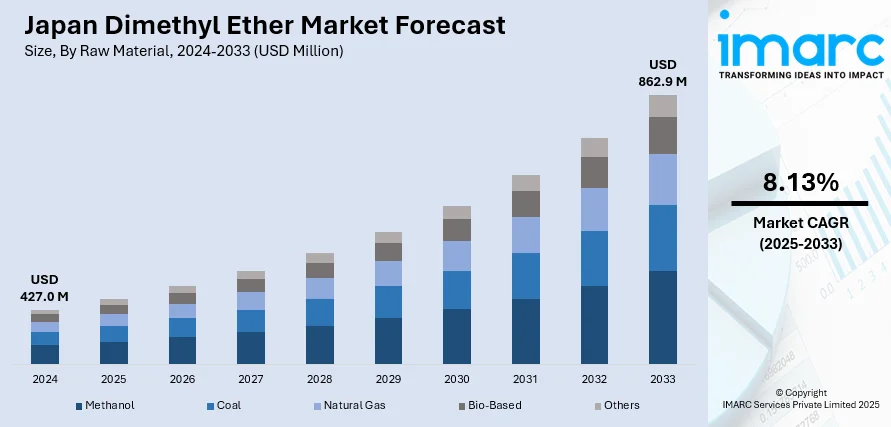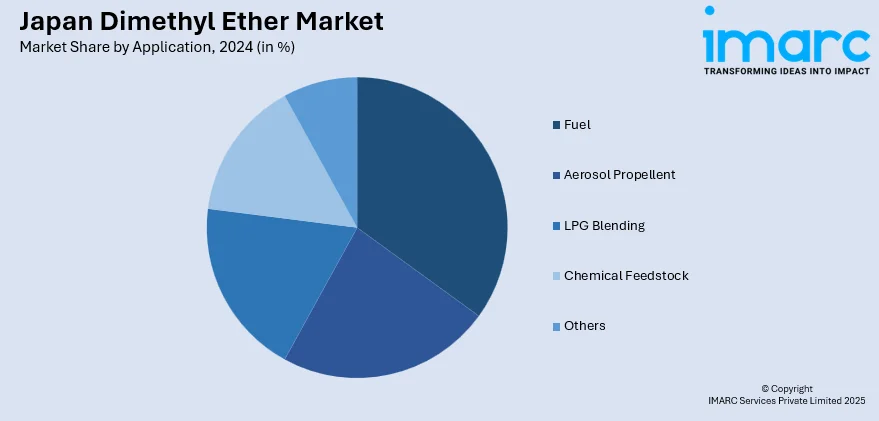
Japan Dimethyl Ether Market Size, Share, Trends and Forecast by Raw Material, Application, End Use Industry, and Region, 2025-2033
Japan Dimethyl Ether Market Overview:
The Japan dimethyl ether market size reached USD 427.0 Million in 2024. Looking forward, IMARC Group expects the market to reach USD 862.9 Million by 2033, exhibiting a growth rate (CAGR) of 8.13% during 2025-2033. The market is witnessing significant growth, driven by the adoption of dimethyl ether as a clean alternative fuel in transportation and expansion of DME applications in the chemical industry.
|
Report Attribute
|
Key Statistics
|
|---|---|
|
Base Year
|
2024 |
|
Forecast Years
|
2025-2033
|
|
Historical Years
|
2019-2024
|
| Market Size in 2024 | USD 427.0 Million |
| Market Forecast in 2033 | USD 862.9 Million |
| Market Growth Rate 2025-2033 | 8.13% |
Japan Dimethyl Ether Market Trends:
Adoption of Dimethyl Ether (DME) as a Clean Alternative Fuel in Transportation
In Japan, there is a discernible shift towards the adoption of dimethyl ether (DME) as a clean alternative fuel within the transportation sector. This movement is primarily driven by Japan's commitment to reducing greenhouse gas emissions and achieving carbon neutrality by 2050. DME's properties, including its high cetane number and soot-free combustion, position it as an attractive substitute for conventional diesel fuel. For instance, in June 2024, MGC began producing Japan’s first bio-methanol from digester gas at its Niigata Plant, achieving ISCC PLUS certification and supporting Niigata’s carbon-neutral goals through sustainable local biomass use. The Japanese government has taken steps to support research and development projects to integrate DME into the existing fuel systems. Working with governmental agencies, research bodies, and private companies, the challenges associated with the utilization of DME, including its storage and distribution logistics, compatibility with engines, and fuel handling features, have been addressed on technical grounds. Pilot programs are ongoing to evaluate the feasibility of DME-powered public transport vehicles, such as buses and trucks, which, in turn, would help reduce urban air pollution and dependability on imported fossil fuels. Meanwhile, Japan's automotive industry is looking into the development of DME-compatible engines and retrofit technologies for use as transition tools from regular fuels. These cooperative efforts thus show that Japan has a strategy for broadening its energy base and, in so doing, fostering sustainable transport solutions through the adoption of DME.

Expansion of DME Applications in the Chemical Industry
The Japanese chemical industry is increasingly recognizing the potential of dimethyl ether (DME) as a versatile chemical feedstock. DME serves as an intermediate in the production of various valuable chemicals, including dimethyl sulfate, acetic acid, and olefins, which are integral to numerous industrial processes. The drive towards more sustainable and efficient chemical production methods has led Japanese chemical manufacturers to explore DME's applications in synthesizing high-value products. For instance, in November 2024, Idemitsu Kosan and Mitsubishi Gas Chemical will build an e-methanol and biomethanol supply system in Japan by 2026 to support eco-friendly marine fuel and cut greenhouse gas emissions. Additionally, the utilization of DME aligns with Japan's environmental objectives by offering pathways to reduce carbon emissions and enhance energy efficiency in chemical manufacturing. Research initiatives are focusing on optimizing catalytic processes for DME conversion to maximize yield and minimize energy consumption. Strategic partnerships between academia and industry are fostering innovation in this domain, aiming to position Japan as a leader in sustainable chemical production technologies. The expansion of DME applications within the chemical sector reflects a broader trend of integrating environmentally friendly feedstocks into industrial operations, thereby contributing to Japan's overarching goals of sustainability and technological advancement.
Japan Dimethyl Ether Market Segmentation:
IMARC Group provides an analysis of the key trends in each segment of the market, along with forecasts at the region level for 2025-2033. Our report has categorized the market based on raw material, application, and end use industry.
Raw Material Insights:
- Methanol
- Coal
- Natural Gas
- Bio-Based
- Others
The report has provided a detailed breakup and analysis of the market based on the raw material. This includes Methanol, Coal, Natural Gas, Bio-Based, and Others.
Application Insights:

- Fuel
- Aerosol Propellent
- LPG Blending
- Chemical Feedstock
- Others
A detailed breakup and analysis of the market based on the application have also been provided in the report. This includes Fuel, Aerosol Propellent, LPG Blending, Chemical Feedstock, and Others
End Use Industry Insights:
- Oil and Gas
- Automotive
- Power Generation
- Cosmetics
- Others
A detailed breakup and analysis of the market based on the end use industry have also been provided in the report. This includes Oil and Gas, Automotive, Power Generation, Cosmetics, and Others.
Regional Insights:
- Kanto Region
- Kansai/Kinki Region
- Central/ Chubu Region
- Kyushu-Okinawa Region
- Tohoku Region
- Chugoku Region
- Hokkaido Region
- Shikoku Region
The report has also provided a comprehensive analysis of all the major regional markets, which include Kanto Region, Kansai/Kinki Region, Central/ Chubu Region, Kyushu-Okinawa Region, Tohoku Region, Chugoku Region, Hokkaido Region, and Shikoku Region.
Competitive Landscape:
The market research report has also provided a comprehensive analysis of the competitive landscape. Competitive analysis such as market structure, key player positioning, top winning strategies, competitive dashboard, and company evaluation quadrant has been covered in the report. Also, detailed profiles of all major companies have been provided.
Japan Dimethyl Ether Market News:
- In February 2025, Nishi Nihon JR Bus, ENEOS, and Hino Motors announced they will operate Japan’s first Expo shuttle buses using synthetic fuel made from renewable hydrogen and CO₂ during the Osaka-Kansai Expo. Supported by NEDO’s Green Innovation Fund, the fuel is produced at ENEOS’s demonstration plant, significantly reducing lifecycle carbon emissions.
Japan Dimethyl ether Market Report Coverage:
| Report Features | Details |
|---|---|
| Base Year of the Analysis | 2024 |
| Historical Period | 2019-2024 |
| Forecast Period | 2025-2033 |
| Units | Million USD |
| Scope of the Report | Exploration of Historical Trends and Market Outlook, Industry Catalysts and Challenges, Segment-Wise Historical and Future Market Assessment:
|
| Raw Materials Covered | Methanol, Coal, Natural Gas, Bio-Based, Others |
| Applications Covered | Fuel, Aerosol Propellent, LPG Blending, Chemical Feedstock, Others |
| End Use Industries Covered | Oil and Gas, Automotive, Power Generation, Cosmetics, Others |
| Regions Covered | Kanto Region, Kansai/Kinki Region, Central/ Chubu Region, Kyushu-Okinawa Region, Tohoku Region, Chugoku Region, Hokkaido Region, Shikoku Region. |
| Customization Scope | 10% Free Customization |
| Post-Sale Analyst Support | 10-12 Weeks |
| Delivery Format | PDF and Excel through Email (We can also provide the editable version of the report in PPT/Word format on special request) |
Key Questions Answered in This Report:
- How has the Japan dimethyl ether market performed so far and how will it perform in the coming years?
- What is the breakup of the Japan dimethyl ether market on the basis of raw material?
- What is the breakup of the Japan dimethyl ether market on the basis of application?
- What is the breakup of the Japan dimethyl ether market on the basis of end use industry?
- What is the breakup of the Japan dimethyl ether market on the basis of region?
- What are the various stages in the value chain of the Japan dimethyl ether market?
- What are the key driving factors and challenges in the Japan dimethyl ether?
- What is the structure of the Japan dimethyl ether market and who are the key players?
- What is the degree of competition in the Japan dimethyl ether market?
Key Benefits for Stakeholders:
- IMARC’s industry report offers a comprehensive quantitative analysis of various market segments, historical and current market trends, market forecasts, and dynamics of the Japan dimethyl ether market from 2019-2033.
- The research report provides the latest information on the market drivers, challenges, and opportunities in the Japan dimethyl ether market.
- Porter's five forces analysis assist stakeholders in assessing the impact of new entrants, competitive rivalry, supplier power, buyer power, and the threat of substitution. It helps stakeholders to analyze the level of competition within the Japan dimethyl ether industry and its attractiveness.
- Competitive landscape allows stakeholders to understand their competitive environment and provides an insight into the current positions of key players in the market.
Need more help?
- Speak to our experienced analysts for insights on the current market scenarios.
- Include additional segments and countries to customize the report as per your requirement.
- Gain an unparalleled competitive advantage in your domain by understanding how to utilize the report and positively impacting your operations and revenue.
- For further assistance, please connect with our analysts.
 Request Customization
Request Customization
 Speak to an Analyst
Speak to an Analyst
 Request Brochure
Request Brochure
 Inquire Before Buying
Inquire Before Buying




.webp)




.webp)












